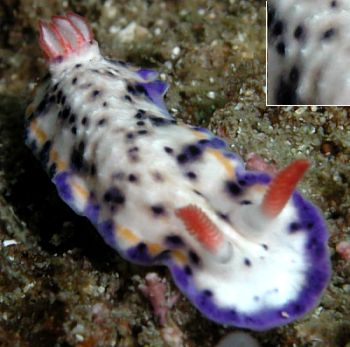
Hypselodoris sagamiensis
(Baba, 1949)
Order: NUDIBRANCHIA
Suborder: DORIDINA
Superfamily: EUDORIDOIDEA
Family: Chromodorididae
DISTRIBUTION
Known only from Japan.
PHOTO
Echizen Coast, Japan, 11-12 August 2001. Upper right: 30mm, Lower right: 20mm, Lower left: 15mm. Photos: Nishina Masayoshi.
Mantle translucent, sometimes with much of the mantle covered with opaque white. In other cases there is little opaque white pigmentation on the mantle except for low raised pustules in the central region, and a broad irregularly shaped band around the margin. There are smaller black spots scattered over the mantle and some larger diffuse black patches forming a band around the mantle just at the outer edge of the visceral mass. At the edge of the mantle is a band of purple, usually entire around the anterior end but breaking into a series of patches along the sides. Inside the purple margin is a broken band of ornage-yellow. The rhinophore stalk is white and the club red. The simple gills are translucent white with red edging. The low pustules covering the mantle are a characteristic feature of the species.
This species is one of only two species of Hypselodoris which are reported to lack mantle glands (Baba, 1995; Gosliner & Johnson, 1999).
References:
• Baba, K. (1949) Opisthobranchia of Sagami Bay collected by His Majesty The Emperor of Japan. Iwanami Shoten, Tokyo. 194pp., 50 Pls.
• Baba, K (1995) Anatomical and taxonomical review of the four blue-patterned species of Hypselodoris (Nudibranchia: Chromodorididae) from Japan. Venus, The Japanese Journal of Malacology, 54(1): 1-15.
• Gosliner, T.M. & Johnson, R.F. (1999) Phylogeny of Hypselodoris (Nudibranchia: Chromodorididae) with a review of the monophyletic clade of Indo-Pacific species, including descriptions of twelve new species. Zoological Journal of the Linnean Society, 125: 1-114.
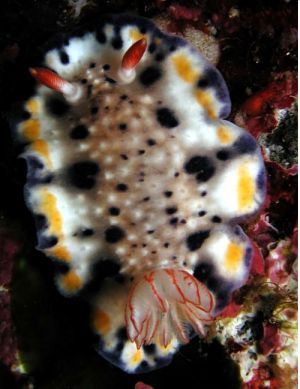
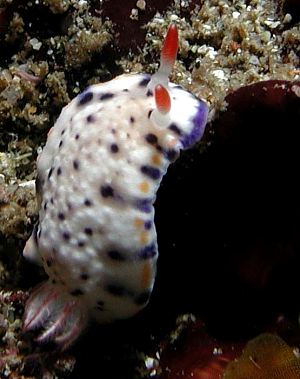
Rudman, W.B., 2001 (August 29) Hypselodoris sagamiensis (Baba, 1949). [In] Sea Slug Forum. Australian Museum, Sydney. Available from http://www.seaslugforum.net/find/hypssaga
Related messages
Hypselodoris sagamiensis from Indonesia
October 17, 2007
From: F. & P. Pellet
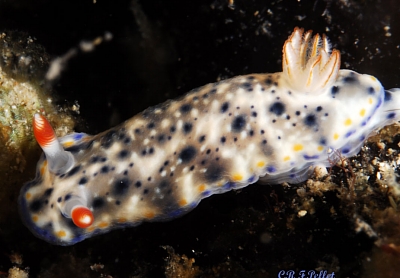
Hi Bill,
After some hesitation, we have identified this nudibranch as Hypselodoris sagamiensis. We found it feeding on a black sponge (middle right photo). We would like to know if you agree with our ID.
Locality: Lembeh Straits, 12m, Indonesia, Celebes Sea, 26 09 2007, Sandy bottom . Length: 25 mm. Photographer: Francis Pellet.
We enclose also a picture of a 5 mm juvenile specimen (pic 3: depth 17m, Mawali Wreck, 28-Sept-2007) Could this be a juvenile of H.sagamiensis?
Thank you for your help once again.
Best Wishes
Francis & Pirjo
pirjo.pellet@free.fr
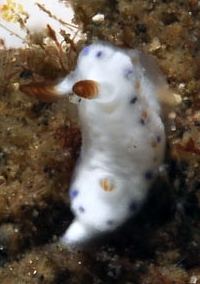
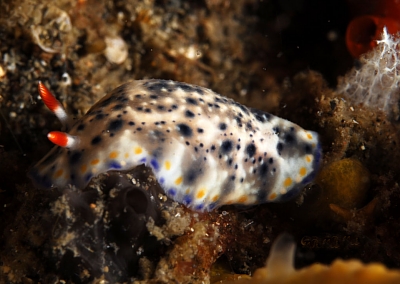
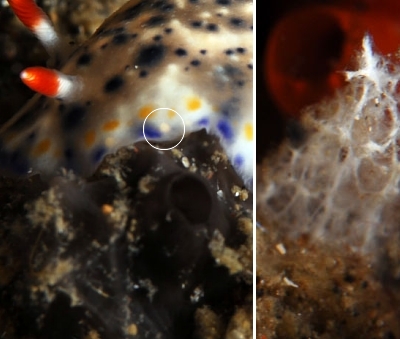
Dear Francis & Pirjo,
This is a nice find. Yes I agree its H. sagamiensis which is very interesting because it provides a link between what we thought was the "home range" of this species in the Sino-Japanese region of the north Pacific and the large populations Gary Cobb [#19421] has reported from southern Queensland in eastern Australia. It looks like this species, rather than being endemic to the north-eastern Pacific has a wider distribution at least in the tropical western Pacific. As I discuss in Gary Cobb's message, this has an interesting similarity to the way the distribution of H. maritima , which was initially considered a Japanese endemic, was extended firstly to eastern Australia and then the intervening region was gradually filled in.
Concerning the juvenile. With the usual hesitation in identifying juveniles, I am pretty sure this is also H. maritima.
Thanks also for the sponge photo. Dark coloured sponges are always a problem to interpret from photos as much of the detail is lost in the shadows. It certainly could be a species of Euryspongia but I can't be sure. While concentrating on the detail, I almost missed the whitish mass on the right side of your feeding photo. As you can see in the close-up, it is the fibrous skeleton of a dysideid sponge - probably the same as the one the Hypselodoris is eating. Although I can't be sure, it seems reasonable to assume that this slug has eaten the first bit and has now moved on to the next bit - they may both be parts of the same colony. I think we can make a tentative determination that this species feeds on a dysideid sponge, possibly Euryspongia sp. This is the first indication we have of the feeding choice of this species.
I have also ringed a white spot on the edge of the mantle [middle photo]. This is one of the mantle glands which store distasteful chemicals from their sponge prey. In species of Hypselodoris and closely related genera the mantle glands are like this - discrete spherical or ovate sacs, quite different from the dendritic glands found in species of Chromodoris.
Best wishes,
Bill Rudman
Re: Hypselodoris rudmani from sthn Queensland?
June 5, 2007
From: Bruce Wilkie
Concerning message #18272:
Hi Bill,
I received a message from Richard Willan regarding my message on a possible Hypselodoris rudmani. He thinks it is Hypselodoris sagamiensis. What do you think?
Regards,
Bruce Wilkie.
brucewilkie@yahoo.com.au
Wilkie, B., 2007 (Jun 5) Re: Hypselodoris rudmani from sthn Queensland?. [Message in] Sea Slug Forum. Australian Museum, Sydney. Available from http://www.seaslugforum.net/find/19985Dear Bruce,
Thanks for letting me know. I am afraid I must get in a confused state when H. rudmani is mentioned. I think of H. sagamiensis as a 'black-spotted' species so it didn't enter my list of possibilities when I tried to identify your animal, but I am sure Richard is correct. This is apparently a colour variant in which black spots are absent except for a very few near the mantle edge. It also lacks most blue spots down each side of the mantle. But the opaque white bumps all over the mantle and the other elements of the colour pattern are the same as in Gary Cobb's recent specimens [#19421] from southern Queensland.
I'm glad we have that sorted out
Best wishes,
Bill Rudman
Hypselodoris rudmani from sthn Queensland?
June 4, 2007
From: Bruce Wilkie
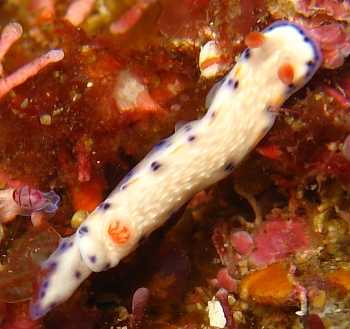
Concerning message #17554:
Hi Bill,
This may be a shot in the dark but, I found this animal in June 2006, and I find myself in a similar situation to Colin. If this animal is Hypselodoris rudmani then it is a long way from "home". I have spent quite some time trying to id it. The closest I have come is one of the animals in Colin`s message #17554. It is possibly a color form of H. maculosa, but to me it does not fit H.maculosa (banding on the rhinophores). What do you think?
Locality: Shag Rock, Point Lookout, North Stradbroke Island., 8 metres, Queensland Australia, Pacific ocean, 03 June 2006, rocky reef with sponges, hard & soft corals . Length: 15mm. Photographer: Bruce Wilkie.
PS. The other animal in the photo I think is Bullina lineata.
Many Thanks,
Bruce Wilkie.
brucedwilkie@yahoo.com.au
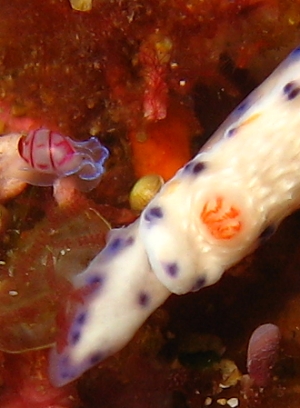
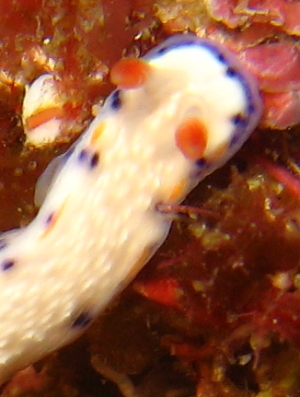
Note added 5 June 2007: This is H. sagamiensis see message #19985.
Dear Bruce,
I'll do the easy bit first - yes the little bubble shell is a juvenile Bullina lineata.
As to the Hypselodoris. I feel a bit of failure not being able to identify a species named after me with certainty, but I would hesitate to say that this is H. rudmani - but then again it definitely has similarities to the animal in Colin's message which you refer to. H. rudmani was described from the NE coast of South Africa so it most probably has a wider distribution in at least the Indian Ocean. Perhaps Terry Gosliner or Rebecca Johnson could give us their opinion.
Best wishes,
Bill Rudman
Hypselodoris sagaminensis from southern Queensland
February 14, 2007
From: Gary Cobb
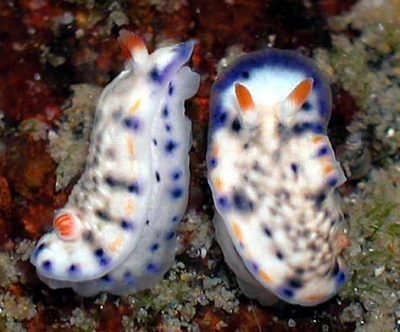
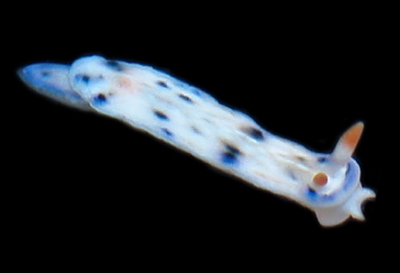
Hi Bill.
After reading the Forum entry about Hypselodoris infucata [message #19388], I thought I might bring you up to speed. In the 5 years of searching for nudibranchs here on the Sunshine Coast, we have found that Hypselodoris sagamiensis is a fairly common species. I have found hundreds of them in our search around Old Woman Island and local reefs. In our book Undersea Jewels [page 162 ] you will see it is fairly common here. As far as Richard Willan is concerned I am the first to record it in Australia. David Harasti down in New South Wales has found it there as well!
Locality: Mooloolaba Sunshine Coast, 6-18m, Queensland, Pacific Ocean, many times, Subtidal. Length: max. 15mm. Photographer: Gary Cobb.
Cheers Gary
http://www.nudibranch.com.au/
gary@nudibranch.com.au
Cobb, G.C., 2007 (Feb 14) Hypselodoris sagaminensis from southern Queensland. [Message in] Sea Slug Forum. Australian Museum, Sydney. Available from http://www.seaslugforum.net/find/19421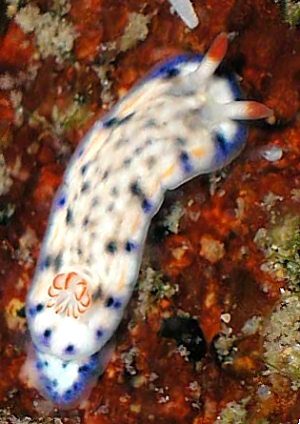
Thanks Gary,
I was 'up to speed' on your finds of H. sagamiensis in southern Queensland, from your book, but I needed a photo or message to add it to the Forum. I wish I had time to search all the other excellent websites to pick up new distribution records but as you no doubt realise, I don't. When I said it was only known from the north west Pacific I was thinking in terms of what I was considering to be its 'natural' distribution.
The presence of H. sagamiensis in eastern Australia is interesting in itself, and it reminds me of H. maritima, which for a long time was known only from Japan and eastern Australia. As I mentioned recently [message #18625] there was some thought that its presence in Australia was due to shipping, but we now have a number of records from places in between, suggesting it may be naturally found all through the western Pacific. At present H. sagamiensis seems to have a similar distribution in the north west Pacific and eastern Australia. It will be interesting to see if it begins to turn up in the tropical Pacific between these two regions.
Another equally interesting possibility is that H. sagamiensis is a colour form of H. maritima. Much of the basic pattern of the two species is the same, the main difference being that the longitudinal lines in H. maritima are replaced by spots in H. sagamiensis. However if we look at an earlier message from Erwin Koehler [#13910], it seems that H. maritima can have black spots instead of lines.
Thanks for sending the photos, they certainly reminded me of your find, and hopefully they have opened up an interesting line of investigation
Best wishes,
Bill Rudman
Re: Colour forms of Hypselodoris infucata
March 27, 2006
From: Richard O'Sullivan
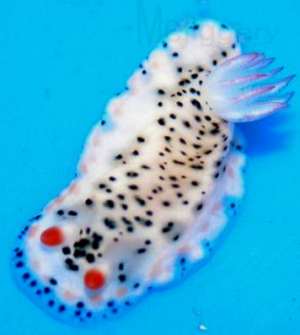
Concerning message #345:
Hi I found this in my home aquarium could you please tell me is it a Hypselodoris infucata. I live in the UK so it must have come with some live rock. I have`nt bought anything new that i could have hitchiked with for a long time probably 6 months. I have noticed i had lots of sponges down the back of my tank which have now gone so I'm assuming this would most likely be the culprit.
Thankyou
Richard O'Sullivan.
oaks27@hotmail.com
O'Sullivan, R., 2006 (Mar 27) Re: Colour forms of Hypselodoris infucata. [Message in] Sea Slug Forum. Australian Museum, Sydney. Available from http://www.seaslugforum.net/find/16146Dear Rick,
Your animal has similarities to H. infucata but I am pretty sure it is the Japanese species Hypselodoris sagamiensis. I won't even try and explain how it ended up in a UK aquarium, but allowing for a bit of overexposure in your photo I am pretty sure this is what it is.
Best wishes,
Bill Rudman
Hypselodoris sagamiensis from Echizen
September 3, 2002
From: Nishina Masayoshi
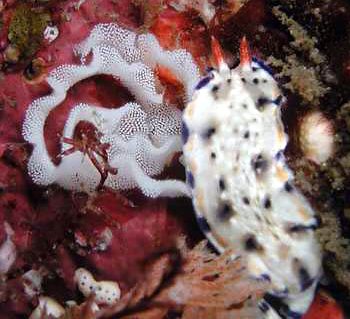
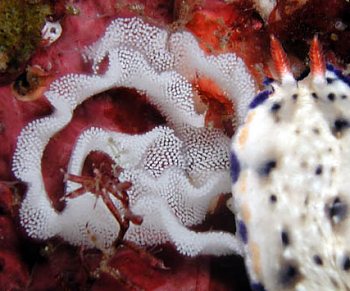
Dear Bill,
The Echizen coast in winter is very cold and rough. It's a very severe winter for nudibranchs. The period when they can become active is for the three months from July to September. The population explodes during this summer period.
Date: 3 Aug 2002
Location: Echizen coast, Fukui pref. Japan
Length: 10mm
Depth: 6m
Water temp: 27C degree
Photo: M.Nishina
Best Regards,
Nishina Masayoshi
nishina@wips.co.jp
Masayoshi, N., 2002 (Sep 3) Hypselodoris sagamiensis from Echizen. [Message in] Sea Slug Forum. Australian Museum, Sydney. Available from http://www.seaslugforum.net/find/7720Dear Nishina,
I separated these photos from your message about Hypselodoris maritima as these are the similarly coloured species Hypselodoris sagamiensis. Can you confirm these are its egg ribbons?
Best wishes,
Bill Rudman
Hypselodoris sagamiensis from Japan
September 1, 2001
From: Nishina Masayoshi

Dear Dr.Rudman,
Here are some photos of Hypselodoris sagamiensis. This is also very common in Sagami Bay and Echizen Coast.
These three photos were taken at the Echizen Coast, Japan, 11-12 August 2001. Upper right: 30mm, Lower right: 20mm, Lower left: 15mm.
Best Regards,
Nishina Masayoshi
nishina@hpe15.wips.co.jp


Dear Nishina,
Thanks for these photos. I think I have only seen a couple of photos of H. sagamiensis before. This species is very interesting in having quite strongly developed pustules on the mantle, which is unusual in the family Chromodorididae. Another unusual feature is that no-one has found mantle glands in this species. In species of Hypselodoris the mantle glands are usually small sacs around the mantle edge, and in many species they become much larger and numerous around the posterior end of the mantle.
Best wishes,
Bill Rudman
